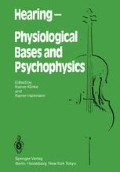Abstract
With the increasing certainty that cochlear mechanics is the determining factor in auditory sensitivity and frequency selectivity, we need to develop our understanding of the evoked biomechanical responses of the cochlea just as we have come to understand and use its electrophysiological responses. Here we compare and contrast ear canal manifestations of cochlear biomechanics in human and gerbil, and consider some parallels with the round window potential.
Access this chapter
Tax calculation will be finalised at checkout
Purchases are for personal use only
Preview
Unable to display preview. Download preview PDF.
References
Anderson, S.D. and Kemp, D.T. (1979) The evoked cochlear mechanical response in laboratory primates. Arch. Otorhinolaryngol. 224, 47–54.
Kemp, D.T. (1979). Evidence of mechanical nonlinearity and frequency selective wave amplification in the cochlea. Arch. Oto-Rhino-Laryngol. 224, 37–45.
Kemp, D.T. (1982) Cochlear echoes-implications for noise-induced hearing loss. In: New perspectives in noise-induced hearing loss. (D. Henderson et al., eds). pp 189–207. Raven Press, New York.
Kemp, D.T. and Chum, R. (1980) Observations on the generator mechanism of stimulus frequency acoustic emissions-two-tone suppression. In: Psychophysicals physiological and behavioural studies in hearing. Kemp, D.T. and Chum, R. eds). pp 34–41. Delft University Press.
Kim, D.O. (1980) Cochlear mechanics: implications of electrophysiological and acoustical observations. Hearing Res. 2, 297–317.
Wilson, J.P. (1980) The combination tone, 2fl-f2, in psychophysics and ear canal recording. In: Psychophysicals physiological and behavioural studies in hearing. Wilson, J.P, eds). pp 43–73. Delft University Press.
Schmiedt, R.D. and Adams, G.D. (1981) Stimulated Acoustic emissions in the ear canal of gerbil. Hearing Res. 5, 295–305.
Zwicker, EI and Manley, G. (1981) Acoustical responses and suppression-period patterns in guinea pigs. Hearing Res. 4, 43–52.
Author information
Authors and Affiliations
Editor information
Editors and Affiliations
Rights and permissions
Copyright information
© 1938 Springer-Verlag Berlin Heidelberg
About this paper
Cite this paper
Kemp, D.T., Brown, A.M. (1938). A Comparison of Mechanical Nonlinearities in the Cochleae of Man and Gerbil from Ear Canal Measurements. In: Klinke, R., Hartmann, R. (eds) HEARING — Physiological Bases and Psychophysics. Springer, Berlin, Heidelberg. https://doi.org/10.1007/978-3-642-69257-4_13
Download citation
DOI: https://doi.org/10.1007/978-3-642-69257-4_13
Publisher Name: Springer, Berlin, Heidelberg
Print ISBN: 978-3-642-69259-8
Online ISBN: 978-3-642-69257-4
eBook Packages: Springer Book Archive

